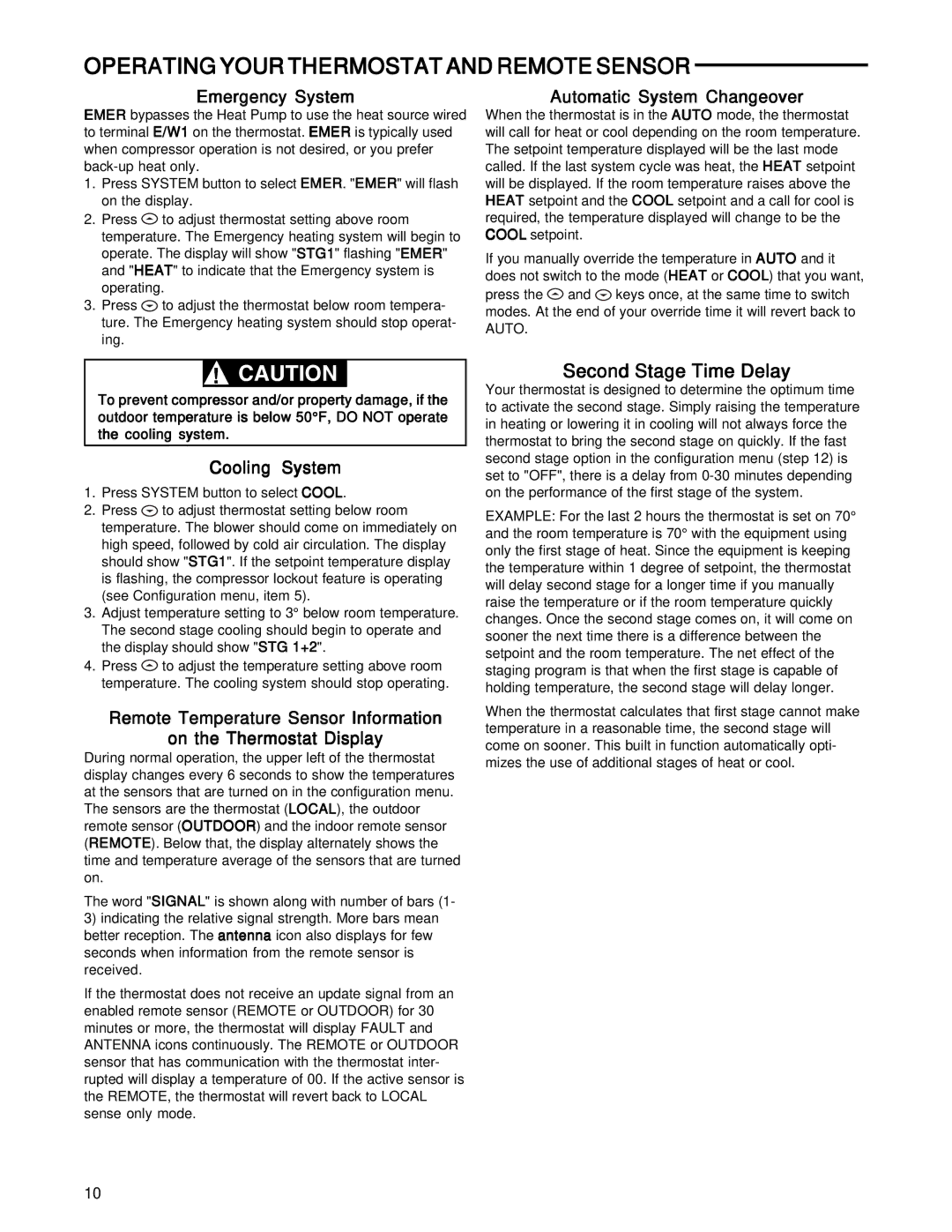
OPERATING YOUR THERMOSTAT AND REMOTE SENSOR
Emergency System
EMER bypasses the Heat Pump to use the heat source wired to terminal E/W1 on the thermostat. EMER is typically used when compressor operation is not desired, or you prefer
1.Press SYSTEM button to select EMER. "EMER" will flash on the display.
2.Press ![]() to adjust thermostat setting above room temperature. The Emergency heating system will begin to operate. The display will show "STG1" flashing "EMER" and "HEAT" to indicate that the Emergency system is operating.
to adjust thermostat setting above room temperature. The Emergency heating system will begin to operate. The display will show "STG1" flashing "EMER" and "HEAT" to indicate that the Emergency system is operating.
3.Press ![]() to adjust the thermostat below room tempera- ture. The Emergency heating system should stop operat- ing.
to adjust the thermostat below room tempera- ture. The Emergency heating system should stop operat- ing.
Automatic System Changeover
When the thermostat is in the AUTO mode, the thermostat will call for heat or cool depending on the room temperature. The setpoint temperature displayed will be the last mode called. If the last system cycle was heat, the HEAT setpoint will be displayed. If the room temperature raises above the HEAT setpoint and the COOL setpoint and a call for cool is required, the temperature displayed will change to be the COOL setpoint.
If you manually override the temperature in AUTO and it does not switch to the mode (HEAT or COOL) that you want, press the ![]() and
and ![]() keys once, at the same time to switch modes. At the end of your override time it will revert back to AUTO.
keys once, at the same time to switch modes. At the end of your override time it will revert back to AUTO.
!CAUTION
To prevent compressor and/or property damage, if the outdoor temperature is below 50°F, DO NOT operate the cooling system.
Cooling System
1.Press SYSTEM button to select COOL.
2.Press ![]() to adjust thermostat setting below room temperature. The blower should come on immediately on high speed, followed by cold air circulation. The display should show "STG1". If the setpoint temperature display is flashing, the compressor lockout feature is operating (see Configuration menu, item 5).
to adjust thermostat setting below room temperature. The blower should come on immediately on high speed, followed by cold air circulation. The display should show "STG1". If the setpoint temperature display is flashing, the compressor lockout feature is operating (see Configuration menu, item 5).
3.Adjust temperature setting to 3° below room temperature. The second stage cooling should begin to operate and the display should show "STG 1+2".
4.Press ![]() to adjust the temperature setting above room temperature. The cooling system should stop operating.
to adjust the temperature setting above room temperature. The cooling system should stop operating.
Remote Temperature Sensor Information
on the Thermostat Display
During normal operation, the upper left of the thermostat display changes every 6 seconds to show the temperatures at the sensors that are turned on in the configuration menu. The sensors are the thermostat (LOCAL), the outdoor remote sensor (OUTDOOR) and the indoor remote sensor (REMOTE). Below that, the display alternately shows the time and temperature average of the sensors that are turned on.
The word "SIGNAL" is shown along with number of bars (1-
3)indicating the relative signal strength. More bars mean better reception. The antenna icon also displays for few seconds when information from the remote sensor is received.
If the thermostat does not receive an update signal from an enabled remote sensor (REMOTE or OUTDOOR) for 30 minutes or more, the thermostat will display FAULT and ANTENNA icons continuously. The REMOTE or OUTDOOR sensor that has communication with the thermostat inter- rupted will display a temperature of 00. If the active sensor is the REMOTE, the thermostat will revert back to LOCAL sense only mode.
Second Stage Time Delay
Your thermostat is designed to determine the optimum time to activate the second stage. Simply raising the temperature in heating or lowering it in cooling will not always force the thermostat to bring the second stage on quickly. If the fast second stage option in the configuration menu (step 12) is set to "OFF", there is a delay from
EXAMPLE: For the last 2 hours the thermostat is set on 70° and the room temperature is 70° with the equipment using only the first stage of heat. Since the equipment is keeping the temperature within 1 degree of setpoint, the thermostat will delay second stage for a longer time if you manually raise the temperature or if the room temperature quickly changes. Once the second stage comes on, it will come on sooner the next time there is a difference between the setpoint and the room temperature. The net effect of the staging program is that when the first stage is capable of holding temperature, the second stage will delay longer.
When the thermostat calculates that first stage cannot make temperature in a reasonable time, the second stage will come on sooner. This built in function automatically opti- mizes the use of additional stages of heat or cool.
10
